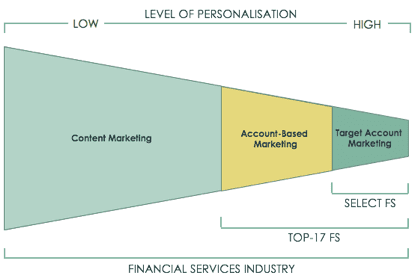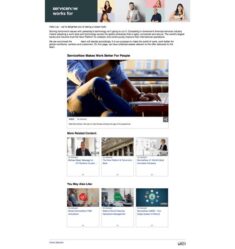ServiceNow’s Approach to Webinar Program Innovation (Part II)
ABMThis is part two in a two-part series on how organizations can extract more results from their webinars. For part one, click here . To learn more about Webinar World London, click here .
The push towards account-based marketing ultimately is about creating the capability to personalize go-to-market strategies and outreach. Webinars – both generic and targeted – play a vital role in ServiceNow’s focus on the Financial Services market.
There are many definitions of Account-Based Marketing going around – it’s a hot topic in Marketing these days. At ServiceNow, ABM is one of three Go-To-Market programs, in addition to Executive Programs and Campaigns.

Figure 1: ServiceNow Go-To-Market Model
Market and Account Segmentations
We segment our markets along a number of axes, and decisions on marketing spend are related to our country tiering model (Tier 1: UK, Germany, France and The Netherlands), the 50 largest accounts for ServiceNow in EMEA, the Executive decision makers (CxO level) within the Top-50, the broader market segment of Large Enterprise organisations, specific industries that historically have proven lucrative for ServiceNow, like Financial Services.
In 2018, we increased our focus on Top-50 accounts. In the first phase of our Account-Based Marketing program, we target 17 Financial Services accounts (banks and insurers) within our EMEA Top-50 account list.
Guided by our London-based ABM agency McDonald Butler Associates, we’re working side by side with Sales leadership and Client Directors to understand how marketing can help accelerate the sales strategy execution within these 17 accounts.
Financial Services: 3 go-to-market modes
To understand the role of the ON24 platform as part of our ABM strategy, I will outline our thinking on a high-level. If we take the triangle from figure 1 and we put it on its side, we see figure 2, where three go-to-market modes in the Financial Services market are identified:
1. Content Marketing for the largest segment in the database. These are the accounts that are in the Financial Services industry, but they’re not strategic enough yet for ServiceNow to focus investment.
2. Account-based marketing for the 17 Financial Services Accounts within the EMEA Top-50 of largest accounts, critical to the future growth of the company.
3. Target Account Marketing for those accounts within Top-17 FS which require even more focus and investments, for instance, because they have been included in a global focus program, or because the sales strategy requires additional marketing investment.

Figure 2: Industry-to-Account-Based Engagement Model
Content Strategies Per Mode
Now that these three modes have been established, we can start devising the content marketing strategy and resources, systems and data services we require per phase over time. To summarize six months of conversations between our sales teams, agencies, and colleagues around the globe:
Seventeen of the EMEA Top-50 accounts our sales organization is going after, are in Financial Services. If we create a content marketing strategy for our target personas in Financial Services, we can start creating an active database in Financial Services within our Tier 1 markets and track who is engaging with ServiceNow, test new ideas, and generate initial demand.
Part of the mix of assets and tactics we employ for this FS content strategy are industry-based messaging frameworks, demo environments, sales decks, blogs, position papers, storybooks, and FS industry event sponsorships – all developed in close cooperation with industry experts and Client Directors.
The ON24 Pillar
In the case of our Financial Services focus, one of the key content strategy pillars is a series of live webinars, running on ON24, reviewing the various parts of our FS value proposition with large FS customers featuring as panel speakers. The recordings of these webinars are used to populate an ON24 Target landing page, with a branded header visual, targeted introduction and the call-to-action to engage the FS discussion groups within the ServiceNow Community.
For the 17 FS accounts within the EMEA Top-50, we go the extra mile by increasing the level of localization of the content and assets. The messaging framework is reworked based on account insights shared by the account director. Co-branded design templates per account show our commitment to work with them. Our executives proactively reach out to their counterparts.
Not only is this a very scalable model, but it also feeds industry-specific content into the long-tail of accounts in the same segment, which are not yet in our Top-50 focus.
In line with the webinar performance metrics we track internally, some of which we shared in Part 1 of this two-part blog, we have seen a significant increase in target account engagement and pipeline influence. The use of ON24’s Target product for ABM has been key to creating the focused content experience, while enabling our marketing metrics to easily demonstrate the increased consumption and engagement via the real-time sync with our CRM system.
Bid Marketing Menu
Once we get to the RFP/bid stage of the engagement, a special programme of activities kicks into action, our so-called “Bid Marketing Menu”, including a targeted brochure aligned with the value themes outlined in the RFP, a branded ON24 Target landing page with messaging and video assets relevant to the offer, email and social media programs to driver further engagement in the account, and real-time engagement monitoring.

Figure 3: Account-based ON24 Target page – account logo blurred out in header visual
Targeted, Personalized Webinars
ON24 Target has enabled the ServiceNow team to introduce targeting and personalization techniques into our webinar programs. We already had the ON24 platform integrated with our website, our Eloqua marketing automation platform and our CRM system, and Tableau already has the dashboards in place to visualize engagement and business value down the funnel, which basically means that these targeted investments are automatically tracked and reported on in our systems, too. So, without much extra effort in the infrastructure layer, we’re able to create actionable insight and higher value for our sales and account teams.
Baseline for 2019 growth
Today, we can show which contacts from our target accounts are engaging our webinar program, including the stage of their engagement and propensity to pipeline and bookings – which is a great baseline for continued growth in 2019 and beyond.
The post ServiceNow’s Approach to Webinar Program Innovation (Part II) appeared first on ON24 .


